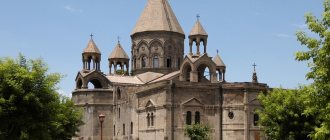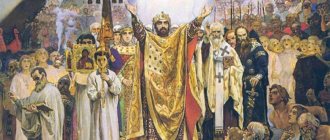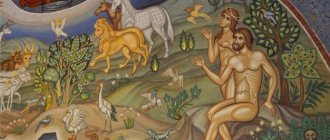Acceptance of faith
The history of the adoption of Christianity in Armenia was passed down by word of mouth until the 5th century, because There was no Armenian alphabet, and therefore no written language. The Holy Tradition of the 5th century, which has come down to our times, testifies that the first preachers of the Christian faith for the Armenians were the two holy apostles of Jesus Christ - Bartholomew (Nathanael) and Judas Thaddeus (Levway). The ruler of the Osroene kingdom, Abgar V Ukkama, was hopelessly ill with leprosy. Having heard about the miracles performed by Jesus Christ, he believed that Jesus was God and the savior.
Abgar sends a letter to Christ, in which he begs for help in healing: “... I am writing to you with a prayer to take the trouble to come to me and cure me of the disease from which I suffer...”. (Apocryphal Gospels) Although Jesus refused a personal visit, he promised: “...When I ascend, I will send one of my disciples here, so that he can cure your illnesses and give life to you and your family.” (Ecclesiastical history, I 13, 10,)
With the letter, the Savior handed over a scarf with his miraculous face. This scarf later became a great shrine for the Armenian people.
After the Ascension of Christ, in fulfillment of the promise, the Apostle Judas Thaddeus arrives in the city of Edessa (the residence of the Armenian king), where he is received with honor as a healer and messenger of the Lord. Thaddeus heals Abgar and brings the good news of the resurrection and ascension of Christ, that humanity will be saved. With Abgar's permission, he preaches Christianity among the people and gathers as many followers as there were people along his path.
In 43, from Osroene, Thaddeus went to pagan Armenia, where in the city of Artaz in the province of Vaspurakan he began to preach the Gospel and founded an episcopate. Tradition contains the names of the bishops of Gavar Artaz in the first two centuries:
- - Zakaria (68-71).
- - Zementos (72-75).
- - Atirnerseh (76-91).
- - Mushe (92-122).
- - Shahen (123-148).
- - Shavarsh (149-169).
- - Gevontios (169-170).
There, in Artaz, Judas Thaddeus meets with the Armenian king Sanatruk I. With his sermons, Judas Thaddeus converts many Armenians from paganism to Christianity, including the daughter of the Armenian king Sandukht.
Yandex pictures
Yandex pictures
Yandex pictures
Yandex pictures
The princes of the royal court spoke out against Christianity. Feeling a strong rejection of the new faith, Sanatruk could not admit that he himself believed in the Savior. He tries to force his daughter to also renounce her faith, but Sadukht does not comply. Even imprisonment did not break her. In 66, Sanatruk gave his daughter a choice - faith or life. The girl chose faith and was executed. A couple of days later, Thaddeus was executed in Shavarshavan. The apostle was nailed to the cross and his body was pierced with arrows. About 2,000 converts were executed along with him. But these events had the opposite effect - fellow believers took the feat of those executed as an example.
Apostle Bartholomew, who was the first to recognize Christ as Lord, also made an invaluable contribution towards the adoption of Christianity in Armenia. In the year 60, with the teachings of Jesus, he first came to the province of Gyukhtn, then continued his theological work in the Ararat region. According to legend, Bartholomew meets Faddem on a hill at the foot of Mount Ararat. A cross was erected at the place where they met.
After meeting with Faddem, Vafrolomei goes deep into the country with the teachings of Christ. In the province of Agbak, the apostle baptized the sister of Sanatruk I, Vogui. Sanataruk, having learned about this, sends his governor Terent to his sister with instructions to force her to renounce her faith. But having become acquainted with the Gospel teaching, having believed in Jesus, Terent was baptized. In the city of Arebanos, all three were captured and subjected to severe torture. Their days were numbered, but they did not renounce their faith. Then Vogui and the military leader were stoned, and Bartholomew was crucified upside down, skinned and beheaded.
The apostles Thaddeus and Bartholomew brought shrines to Armenia that are still revered to this day:
- The tip of the spear that pierced the body of the crucified Jesus.
- Portrait of the Mother of God.
- Oil blessed by Jesus Christ.
Yandex pictures
Thanks to the Gospel teaching of the Holy Apostles, the first communities of the Christian faith arose in Armenia. And despite the brutal persecution and execution of Christians, by the 4th century the faith became widespread.
Story
The date of the appearance of the Christian religion in Armenia falls in the first century AD, that is, immediately after it arose in general. Church tradition says that Christianity in this country was already preached by such holy apostles as Thaddeus and Bartholomew. They founded churches in Armenia and converted many to Christianity. The apostles Jude and Thomas also contributed here, but there is little information about this. Their disciples continued the work of spreading Christianity, preaching and creating communities, churches, and new martyrs arose. Little is known about the further development of Christian communities in this country.
Important: some of the factual sources of information about Christians of those times are the works of Tertullian, as well as the letter of a bishop named Dionysius from Alexandria, which was written in 254.
In certain parts of Armenia, Christianity advanced successfully, but still the path to the adoption of religion at the state level was difficult due to the then persecution of Christians, from Nero to Diocletian. Perhaps due to the fact that Christian tendencies were suppressed in the first two centuries by persecution and martyrdom, history has vague information about this. This article does not touch upon this topic in detail, since it raises the question of the adoption of Christianity as a state religion, and these are later dates - the end of the third - the beginning of the fourth century.
Yandex pictures
Important: when raising the question of who baptized Armenia, the two main characters that mainly come to mind are the ruler of the country named Trdat the Third and the high priest Gregory the Illuminator.
To better understand the issue, one should delve further into the days of the reign of the above-mentioned king.
Before Trdat, Armenia was ruled by his father named Khosrov the Second. He was at enmity with the Persians, namely with the then influential family of the Sassanids, who overthrew the Parthians, the Arsacids, who were related to the kings of Armenia. An alliance was concluded between Khosrow II and the Roman government. Thanks to this, the king managed to inflict several strong defeats on the Sassanids. The Persians were unable to resolve the issue by military means and carried out a cunning special operation. It consisted in the fact that a Parthian prince named Anak Partev, who was a political refugee, was sent to Armenia along with his family.
Important: this family, it turns out, was close to the Armenian dynasty, so Anak was well received and admitted to King Khosrow.
As a result, Anak, upon leaving for the city of Vagharshapat, managed to kill the king and almost his entire family. At the same time, the Persians attacked Armenia. Only the son of Khosrow, named Trdat, escaped. He managed to escape to Rome in 287. He returned to the throne only in 298. This man became known as Trdat the Third Great, the king who baptized Armenia.
By the way, Anak was caught and punished. His whole family also suffered. Only one of his sons managed to escape, thanks to his nanny, and escape to Antioch. The name given to him by birth is not known, but as a result of Christian baptism in Antioch he was given the name Gregory, who then.
Important: it was this Gregory who turned out to be the very high priest of Armenia and the saint called the Enlightener.
How all this happened will be discussed in more detail below.
Christening of the country
The next historical milestone in the Christianization of Armenia was the educational activity of the Hieromartyr Gregory Lusavorich.
The life of Gregory (“The Book of Grigoris” or otherwise “Teaching of the Enlightener”) by the Armenian historian of the 5th century Agafangel says that Apak, Gregory’s father, was seduced by the monetary reward of the Persian king and, at his direction, killed Khosrow II, who was ruling Greater Armenia at that time. The killer's family was destroyed out of revenge. Only one boy managed to escape, the youngest son of Apak, who was sheltered by a Christian nurse and taken to Cappadocia, where the boy was baptized and received a Christian education. At baptism the boy was given the name Gregory.
Returning to his homeland, Lusavorich comes to the palace to faithfully serve King Tiridates III in the hope of atonement for the guilt of Apak with devotion. But the pagan rituals performed at court disgust his soul and Christian foundations. One day he can’t stand it and dares to refuse to take part in them (according to other sources, Tiridates found out whose son he is). For this, Tiridates the Great put Gregory in the Khor Virap prison in Artashat, which was famous for its terrible conditions and the fact that no one ever returned from it.
Lusavorich was periodically subjected to severe torture: he was hung upside down with a stone around his neck, forced to walk in iron boots with nails inside, doused with hot tin, and thrown into a ditch filled with poisonous snakes. During the torture, Gregory sang psalms and time after time appeared before Tiridates alive and unharmed with unshakable faith in Jesus Christ, which infuriated the king even more. The imprisonment and torture continued for 14 years.
During this time, Tiridates committed an atrocity, the consequences of which changed the fate of Gregory and served to establish Christianity on Armenian land. The following happened.
The Roman Emperor Diocletian wanted to marry a very beautiful nun, Hripsimia, against her will. Knowing the wishes of the emperor, the abbess of the Gayane monastery, Hripsimia and about 33 nuns left the monastery of St. Poghos at night. The fugitives went to Egypt, to Alexandria, and then to Jerusalem, where for a month they prayed at the grave of the mother of Jesus, asking her for protection and help. The Virgin Mary appeared to the women and ordered them to go to Armenia, where they headed.
Yandex pictures
Diocletian found out about the whereabouts of Hripsimia and sent Tiridates a letter asking him to return the nun to Rome or marry her himself, which the Armenian king tried to do. But Hripsimia refused, declaring that she was already engaged to Christ and marriage was impossible for her. Then Tiridates martyred Hripsimia. She was deprived of her eyes and tongue, her stomach was ripped open and her body was cut into pieces. Abbess Gayane was also tortured and brutally executed for her support for the rebellious Hripsimiya. The rest of the nuns were thrown to be eaten by wild animals. This event dates back to 300-301.
According to legend, after this the wrath of the Lord fell upon Tiridates and the soldiers who took part in the bloody execution. They gnawed at their bodies like animals. In the 5th century, this disease was nicknamed “pig disease” and because of this, sculptors depicted Tiridates with the head of a pig.
The king's sister Kusarodukhta sympathized with Gregory and God chose her to save Christian Armenia. In a dream, she heard the voice of God: “You will not be healed from the punishment that has befallen you unless you send a man to the city of Artashat for Gregory, who is imprisoned there.” (The Story of Agafangel. The Book of Grigoris)
Lusavorich was immediately released. The former prisoner ordered to bury the tortured nuns and build three chapels at the burial site of the virgins. There Tiridates was healed through prayers, believed and repented. January 6, 301 is the date when Gregory baptized the king and his court. Then all of Armenia was baptized.
Yandex pictures
Adoption of Christianity in Armenia
The adoption of Christianity in Armenia is one of the most amazing events in world history.
Armenia is the first Christian country. It was here in 301. For the first time, Christianity acquired the status of a state religion. This event is associated with the names of King Trdat III and the first patriarch of the Christian world, Gregory the Illuminator.
This incident has many mysterious aspects that still puzzle historians. In addition to the fact that the adoption of Christianity was unprecedented, it was also the only time a change of religion occurred without a change in power and without the influence of a more powerful culture. The powerful and cruel king Trdat III persecuted Christians in every possible way, bloodthirstyly killed them, applied the most heartless and brutal punishments and did not allow religion to spread in any way. And now the same king Trdat, glorified as a firm and powerful ruler, recognizes Christianity and orders to spread the religion throughout the country. The question of what happened to the king is answered by a dramatic, extraordinary story that has survived to this day.
Where did it all start?
In the middle of the 2nd century. Armenia was ruled by the powerful and intelligent king Khosrov. During his reign, Armenia flourished greatly: it expanded its borders, defeated all its enemies, and freed itself from internal enemies. Princes who brought harm to the country were punished, others who were in a quarrel were reconciled. But one day, a plot is hatched against Khosrow and he is treacherously killed.
The dying king's last order was to track down and kill, along with their families, everyone who was involved in the regicide. At this time, the killer's wife miraculously manages to escape to Rome and takes away her baby. The murder of Khosrow was ordered by the Persian king in order to seize the Armenian throne. The situation becomes dangerous and the threat falls on the entire royal family. It was necessary to save the king's son and he was also taken to Rome.
The king's son was called Trdat, and the son of the regicide was Gregory. By a twist of fate, they were both dragged to Rome. They were from two enemy clans from which they were rescued. And many years later, they will baptize the Armenian people together.
From friendship to imprisonment
Having matured, Gregory begins to realize the vice of his father. He understands that the murder of the king was a great sin and a disastrous event for Armenia. As a sign of atonement for his father’s guilt, he comes to serve the son of the late king, Trdat, who, however, did not even imagine that Gregory was the son of a regicide. Gregory serves sincerely and with all his heart. He becomes Trdat's most faithful servant and close friend. And despite the fact that Gregory was already a supporter of Christianity, and Trdat hated Christians, the latter loved his servant with all his heart and shared his deepest secrets with him.
And so in 287, the Roman emperor Diacletian sent Trdat to Armenia with a large army. Trdat drives out the Persians who have established their power from the country, and becomes the king of Armenia. The king still could not come to terms with the fact that Gregory is a Christian, and at one of the pagan ceremonies, he orders him to give honor to the pagan goddess. Gregory, naturally, refuses, since he was very devoted to his faith, for which the king subjects him to torment and torture so that he renounces Christianity.
The king, of course, had no intentions of killing his best friend. But it was at this time that he was informed that Gregory, it turns out, was the son of the regicide. Then Trdat can no longer restrain his rage and throws Gregory into the Khor Virap (Deep Pit) dungeon, where the most malicious enemies of the state were thrown. This dungeon was a deep hole where the prisoners were not fed or given water, but were simply dragged out dead after a month or two, when it was the turn of another prisoner.
Acceptance of Christianity
13 years have passed since then and the king falls ill with an incurable disease. The king's sister recalls that Trdat had a devoted servant who was always there in difficult situations and often even helped him out. She immediately sends people for Gregory. At first, it seemed to everyone that she had gone mad, since it was extremely unrealistic that in a dungeon where people could not stand even a month, Gregory would be alive after 13 years of imprisonment. But she insisted that the dungeon be checked. And when they checked, everyone was gripped by fear from the miracle they saw. Gregory turned out to be alive. All emaciated and barely breathing, Gregory lay on the ground. Later it became known that one of the prison employees lowered bread and water to him through the chimney.
Gregory is told what fate befell his king and why he was released. Despite the fact that he had the right to hold a grudge against the king, he still shows his devotion and treats Trdat. After this, Trdat recognizes Christianity and orders the religion to be spread throughout the country. And Gregory becomes the Catholicos (patriarch) of Armenia.
Were there any motives? Armenian Apostolic Church
At first it may seem strange that the history of a few people decided the fate of an entire country. On the other hand, today, this is the most plausible and logical explanation for the radical change in the worldview of the king, who was so firm in his position. It turns out to be extremely difficult to dig out the objective motives for accepting Christianity. It is difficult to find any elementary reasons and explain what happened using the standard laws of history.
From a foreign policy point of view, it was a complete failure. The Persians tried for several centuries to return the Armenians to paganism through wars. Naturally, relations with the Roman emperor Diacletian, who himself installed Trdat on the throne, and who, being an ardent opponent of Christians, naturally did not approve of Trdat’s behavior, also deteriorated. From the point of view of domestic politics, everything was also not so good. Internal wars and bloodshed began, and cultural heritage was destroyed. Therefore, historians do not give a final and unambiguous answer as to why Armenia and why it adopted Christianity in such an absurd way.
There is a small motive for accepting Christianity, which, however, is unlikely to survive as the main reason. It is failure in foreign policy that contains hidden success. By adopting Christianity, Armenia boldly rejects the cultural influence of its powerful neighbors and takes the path of creating its own independent culture. Within 100 years, the Armenians had their own written language and a century of rapid development of historiography and literature began, which was called the “Golden Age”. And, of course, the change of religion did not occur so suddenly. There was a certain ground.
After the resurrection of Christ, two of the 12 apostles arrived in Armenia - Thaddeus and Bartholomew. That is why the Armenian church is called Apostolic, as a sign that the Armenians heard about Christian teaching from the apostles themselves. But Christianity originated in Armenia during the lifetime of Christ. Historians mention the first Christian king Abgar (king of Edesia - a separate Armenian kingdom), who believed that the works of Christ are the works of God and wrote a letter to Christ with a request and invitation to his kingdom, for the salvation of his people. To this Christ replied that he had business in Jerusalem, but promised that he would send his disciple to him.
Thus, Christianity has been penetrating Armenia since the 1st century. At the end of the 3rd century, Christian communities already existed throughout the country, which served as the basis for the proclamation of a new religion as the main one.
At the same time, at the end of the 3rd century, paganism had already weakened greatly. The priests did not serve as spiritual guides. Abuse of social status, deception, intimidation and robbery of the population became the norm on the part of the clergy. The pagan faith was no longer a national traditional faith that would be difficult for Armenians to abandon. There were many borrowings from Greek and Parthian religions, but the original Armenian religion was lost.
Moreover, in time immemorial, Armenians worshiped one god, who, like in Christianity, had three hypostases. It turns out, judging strictly, the adoption of Christianity was a return to monotheism and an approach to the original Armenian religion. Also, biblical teachings were very close to the mentality, national customs and family traditions of the Armenians. Thus, the people were morally ready to accept the new faith.
It is necessary to note, however, the dark sides of the religious revolution. The priests could not come to terms with the fact that in one day they lost all their powers and lost everything. They gathered troops and sent them against Christians and the royal army. The situation began to calm down when the high priest was killed. A lot of blood was shed. The cultural heritage has suffered greatly. Throughout the country, pagan temples were destroyed or Christian ones were built in their place. Many sculptures and manuscripts were destroyed. There is a widespread belief that the Armenians even had their own written language, of which nothing remains, since Christians destroyed everything without thinking about cultural values.
* * *
Despite those troubled times, the role of the church in the history of the Armenian people is difficult to overestimate. During times of loss of statehood, the church took over the leadership of the country and maintained the unity of the people. It was the church that often organized liberation wars and established important diplomatic relations. She opened schools and universities, cultivated national consciousness and patriotic spirit in the population. Having gone through mountains of trials, having survived continuous pressure from cruel invaders of other faiths, the Armenian Church has not lost its status as a state religion for a single day.
Today, the Armenian Apostolic Church unites Armenians living abroad, which makes up 80% of the total Armenian population of the world.
At the state level
In 301, Christianity was proclaimed the state religion of Armenia. Gregory Lusavorich was ordained by the Cappadocian bishops and the ceremony of Gregory's enthronement took place in Ashtishat. Returning to the capital Vagharshapat, Gregory wanted to build a Christian temple. For a long time he could not decide on a place, he chose carefully. God helped him decide:
“The sky opened, and a ray of light descended from it, preceded by a host of angels. Behind them was a human image with a golden hammer in his hand. Where the hammer hit, the earth opened up, and a terrible cry was heard from its depths. Then, at this place, a golden pedestal rose in the form of an altar, from which rose a pillar of fire with a cloud cover, above which a cross shone” (Holy Tradition of the Armenian Church, 5th century).
Thus, in 303, construction began on the Etchmiadzin Temple, which later became a place of pilgrimage for believers from all corners of the Earth.
Yandex pictures
Gregory continued to preach the Gospel teaching among the Armenian people, continued his painstaking work to eradicate pagan thinking and dissent in Armenia. Tiridates, who had been a violent pagan in the past, strongly supported his savior and issued a decree banning paganism.
In 326, Gregory died, having previously ordained his youngest son Aristakes as bishop. The relics of Gregory Lusavorich were buried in Etchmiadzin. He is well known among Christians of all branches as Saint Gregory the Illuminator.
Many of Gregory's descendants were canonized as saints for their great deeds for the glory of Jesus Christ. Until 438, the family of Gregory stood at the head of the episcopal see of Armenia. The youngest son of Gregory - In 325, he brought to Armenia the Nicene decrees, approved by the First Ecumenical Council. Became one of the signers of the Nicene Creed.
Vrtanes
First son of Gregory - Became patriarch after the death of Aristakes. In order to eradicate paganism, he held the annual Great Prayer and Ritual Ceremony in Taron.
Yandex pictures
Grigoris
The eldest son of Vrtanes, grandson of Gregory, is the Bishop of the Agvan throne. He preached to the wild tribes of the North-Eastern Caucasus, the Huns, Mazkuts and other neighboring pagan peoples. Martyrdom.
Yusik
The youngest son of Vrtanes, grandson of Gregory - In 341 he was elected Catholicos. He fought for the preservation of Christian principles in the royal court. Martyrdom.
Nerses
Grandson of Yusik, great-grandson of Gregory. In 354, at the First Armenian National Church Council, which he convened, a number of decisions were made that influenced the development of the Armenian church:
Yandex pictures
- ban on holding funerals with pagan rites;
- found monasteries and nunneries;
- organize charities;
- prohibit marriage with relatives.
The Christianization of Armenia took almost 5 centuries. After Christianity was declared the official religion at the state level in 301, the Armenian Church had to endure more than one shock:
- attack on Armenia by Iranian Shah Shapur II in 337. The purpose of the attack is to exterminate Christians and the entire Christian religion. The Armenians held out and defeated the Iranian troops;
- division of the lands of Greater Armenia between Byzantium and Persia in 387;
- the imposition of the religion of Zoroastrianism and the oppression of Christians by the Persian king Ezdigerid II in 449.
The Armenian clergy and nakharars secured the inviolability of their faith with a document sent to Yezdigerid, the text of which was recorded by the historian Yeghishe:
- “No one can shake us in these beliefs... (...) For we have a vow of faith not with man, so that, like children, we will lie to you, but indissolubly with God...”;
- the first Christian war (date: May 26, 451). The Persians tried to crush the Armenian faith. The war for the right to practice Christianity lasted more than 30 years. In 484, an important event occurred: the signing of the Treaty of Nvarsak, in which the right to practice Christianity was established for the Armenians.
The fundamental foundations of the Armenian Apostolic Church were laid with great difficulty and the blood of believers during the 4th-5th centuries. It strengthened, grew and predetermined the characteristics of Armenian Christianity, marked by the stamp of the heroic faith and steadfastness of the Armenians. There are any number of examples of the heroism of Armenian Christians in defending the Christian faith in the history of the country.
The adoption of Christianity as a single religion united the Armenian people and established high moral values and the concept of morality.
At the highest level of the hierarchical ladder of the Armenian Church is the Catholicos. Receiving the grace of the Holy Spirit at ordination. he also receives the power to transfer it to the bishops, who, in turn, transfer it to the priests during ordination, and the latter to the people. So. The hierarchy of the Armenian Church includes three main degrees of priesthood, whose representatives, through ordination and chrism (confirmation), receive the grace of the Holy Spirit and the power to transmit it to others.Priest - the basic degree of the hierarchical structure. The duty of a priest is shepherding, that is, caring for the spiritual rebirth of people, the spiritual education of believers, as well as performing the sacraments. services and requirements The priest receives priestly authority from the bishop through ordination and confirmation. In the Armenian Church, as in the Orthodox Church, priests are both married and celibate. In order to become a priest, the chosen one must be married for at least a year and have a son. A widower priest can become a monk or marry a second time, as established by Catholicos Gevorg V (1911-1930). The hieromonk (celibate priest), after ordination on the same day, takes a vow of celibacy and puts on a “vsgar” (a special headdress - a hood) as a symbol of renunciation of the world. Marriage priests can reach the rank of archpriest.
Bishop is the highest level of the church hierarchy. The bishopric represents the unity of the Church. A bishop is the head and spiritual leader of all churches of one political-geographical region (diocese). The bishop has the right to ordain and anoint priests and consecrate churches. In the Armenian Church, a bishop is ordained and receives Christianity from the Catholicos. During ordination, the bishop receives the bishop's staff and ring as a sign of authority. Bishops are elected from among the celibate clergy who have the academic degree of archimandrite. Particularly outstanding bishops may receive the honorary title of archbishop.
Catholicos Unlike the Orthodox Churches, in the hierarchy of the Armenian Apostolic Church the head of the Church - the Catholicos - stands one step above the bishops; he receives ordination and chrism from 12 bishops. The Catholicos represents the centralized authority of the Armenian Church. He is the chief legislator and supreme judge. Its competence includes the ordination of bishops, the consecration of St. peace, the blessing of new laws and new holidays, the founding of new dioceses, etc. The Catholicos is elected by the Church-National Council for life. There are also two lower orders in the Armenian Church. Reader (dpir) - currently the reader combines the duties of various servants of the ancient church: psalm-reader, sexton, key-clerk, lamplighter. The deacon is selected from among the readers and ordained as a deacon. His duty is to assist the priest both during divine services and in his pastoral activities.
Academic degrees of the Armenian Church The Armenian Church assigns two degrees of scholarship to its ministers: 1. archimandrite (vardapet) - corresponds to the degree of candidate of sciences, 2. proto-archimandrite (tsayraguyn vardapet) - corresponds to the degree of doctor of sciences. Academic degrees are awarded only to celibate clergy. Only those bishops who have the title of Supreme Archimandrite have the right to confer academic degrees. When conferring an academic degree, the archimandrite is given a staff with a two-headed snake, which symbolizes wisdom and the power given to him to teach and preach.
4. Relics of the Armenian Church The Armenian Church is the custodian of many relics, of which the following are especially significant. The spear that pierced the side of Jesus Christ According to the testimony of the Apostle John, one of the soldiers pierced the side of Jesus Christ who died on the cross with a spear (John 19:34). According to legend, this spear was brought to Armenia by the Apostle Thaddeus. In the Middle Ages, it was kept in the Ayrivank monastery, which was renamed Surb Geghard (Holy Spear). Currently, this relic is kept in Holy Etchmiadzin. The Catholicos of All Armenians sanctifies St. myrrh during the making of peace.
Hand of St. Gregory the Illuminator The relics of saints are preserved and venerated in the Armenian Church. A special place among them is occupied by the right hand of St. Gregory the Illuminator, which is a symbol of the power of the Supreme Patriarch Catholicos of All Armenians. Hand of St. Gregory is kept in St. Etchmiadzin. and St. is also sanctified by it. myrrh during the making of peace.
A piece of wood from Noah's Ark As the Bible says, “the ark rested... on the mountains of Ararat” (Genesis 8:4). According to legend, at the beginning of the 4th century, Bishop Jacob of Nizibia (+350) set himself the goal of climbing to the inaccessible peak of Mount Ararat in order to do so. to see Noah's Ark and take a piece from it. After long, painful days of climbing, Jacob fell asleep at night on a snow-covered mountainside and saw in a dream an angel giving him a piece of Noah's Ark as a reward from God for his patience and faith. Waking up and seeing a piece of petrified wood next to you. Jacob, having praised God, set off on his way back. Currently, a piece of the tree of Noah’s Ark is kept in the monastery of St. Etchmiadzin. In 1766, Catholicos of All Armenians Simeon Yerevaitsi sent a small part of the Ark tree as a gift to Catherine II, thereby expressing gratitude to the Russian Empress for her concern for the Armenian people. The relics of St. are also kept with veneration in Holy Etchmiadzin. John the Baptist, St. Stephen the First Martyr. St. apostles Thaddeus, Bartholomew, and Andrew the First-Called. Thomas and the great saints of the Church of Christ, as well as such shrines as a piece of the Tree of Life-Giving and the Most Honorable Cross of Christ and a piece of the Savior’s Crown of Thorns.










